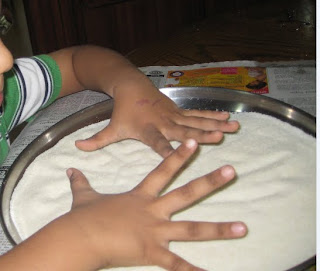Hand Dominance... its relevance
Friday, August 28, 2009

Handedness is an attribute of humans defined by their unequal distribution of fine motor skill between the left and right hands. Some are left handed and some are right handed. However, there are 2 more types of handedness seen, Cross dominance and Ambidextrous. Cross dominance means the child uses one hand for one particular activity and other hand for other specific activity. Ambidextrous is a unique quality that a child can perform a particular skill with both the hands with equal quality. Crossed dominance and ambidextrous is not a problem every time until it affects the function.
Handedness is comprised of hardware (musculoskeletal, strength) and software (neurological), interacting to produce an efficient action. Handedness depends on neurological inhibiting of the recessive hand, so that the dominant hand can develop the precise, corrective, rapid movement without any competition from the non-dominant hand. Generally hand dominance is established at the age of 3 to 4 yrs but as late as 7 yrs. It is important to develop the hand dominance. However most of the child does develop hand dominance spontaneously at age but sometimes children with developmental delay and autism may have problem with it. Parents often have concerns that their children can write from both the hands but not sure.
To develop hand dominance it is important to know the preferred hand of child. Parents and teachers can observe the child in various functional activities. Observe child closely for preference of hand, control, strength and stability. Observe the child in unconscious and sudden or alone without interfering or biasing. It gives a better idea than intentional observation which sometimes becomes biased. Sometimes poor shoulder stability leads the child to keep on shifting the hand which gives a wrong expression of poor hand dominance.
Many activities like horizontal and vertical eight can help in finding the midline orientation and laterality. Bilateral hand activities like scissoring, hammering, tearing the paper, screwing, unliding the bottles, pick up games, lifting heavy objects, push ups and pull ups can be done. Observe the child preference and effort during movements. Once if it gives the idea of hand preferences stimulate that side with graded finger and shoulder exercise.
Posted byNeeti at 10:51 PM 0 comments
Labels: autism, awareness, disability, knowledge sharing, parenting tips
Reading habits...
Thursday, August 20, 2009
To develop reading habits in children with special needs is always a concern for parents. Reading habits are very important for academics. Most of the special need children have poor visual function i.e. fixation, tracking, sorting, depth perception and discrimination. Many a time poor sitting tolerance and hyperactivity make the reading habit a daunting job for the educators and parents.
Tips for developing reading habits
- If hyperactivity is diagnosed as a sensory issue, resolve it with guidance of Early interventionist or occupational therapist.
- Work on developing the visual functions like sorting, matching, tracking and visual discrimination etc. this can be done with lots of visual cues and visual supports.
- Most of autistic children are visual learner, so use this strength to develop reading and matching skills.
- Read lots of story books, depending upon the age and child understanding level, the books can be selected. This not only creates the interest in child but also helps in improving further the visual memory. Repeat the story of the child favourite character and then keep on adding the new concept. For e.g. if the child likes “POOH”, create a story with some more pictures to teach the social skills and other functional activities.
- Be patient as it may require lot of time and efforts. If you are patient the child tend to calm down easily and that further helps you and your objectives.
- Bed time is best time for some children as they are calmer during that time.
- Always remember every child learns with difference pace as every child is special
Posted byNeeti at 3:32 PM 0 comments
Labels: autism, education, parenting tips
Fine Motor Control
Thursday, August 13, 2009
Whenever there is poor fine motor control, the therapy plan should start from the shoulder and back stability exercise. This other way helps in better posture, core stability and better functioning of fine motor control.
Use of therapy ball, full range of shoulder movements (extension, flexion, rotation and circumduction) should be designed and practiced in the form of functional activities like drawing a big circle on wall or on floor in clockwise and anticlockwise direction, stair climbing etc. Various asanas like bhujanasan, tadasan, sarpasan should be practiced if the child understands the commands and above 8 yrs. Younger ones should practice under proper professional guidance. Asans in whole help in developing core stability, flexibility and relaxation
Fine motor activities like tearing the paper, crumbling the big sheet of newspaper, pegs activities, screwing and unscrewing movements, scissoring activities, pasting and folding, balancing, play dough activities, movements with the elastic bands in fingers, art and craft activites with different textures materials, strengthening of various grips and grasps (palmer, pincer, cylindrical, spherical, diagonal volar grasp and tip to tip grasps) etc.
Sometimes poor hand functions are associated with poor visual information process or poor visual perception. Activities should also includes eye hand coordination and midline and laterality orientation. other aspects like fixation, tracking and discrimation
Posted byNeeti at 11:37 PM 0 comments
Labels: autism, awareness, finemotor control, knowledge sharing

